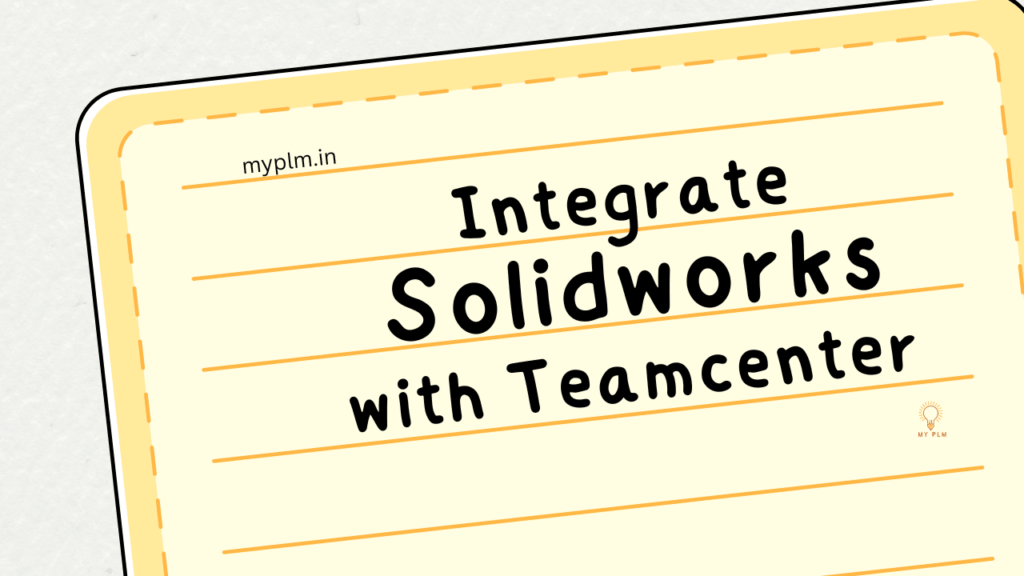Integrating SolidWorks with Teamcenter can significantly enhance your product development workflow by combining the powerful 3D CAD capabilities of SolidWorks with the robust product lifecycle management (PLM) tools of Teamcenter. This integration enables seamless data management, improved collaboration, and streamlined processes. Here’s a step-by-step guide to help you achieve this integration effectively.
Table of Contents
Why Integrate SolidWorks with Teamcenter?
Integration has several benefits, which should be understood before beginning:
1 Centralized Data Management
The Teamcenter ensures consistency and reduces errors by ensuring that all product data has a single source of truth.
2 Enhanced Collaboration
Integration facilitates better collaboration among team members, regardless of their location.
3 Improved Efficiency
Transferring data between SolidWorks and Teamcenter automatically reduces error risks and manual entry.
4 Streamlined Workflows
A seamless integration between design and manufacturing helps streamline the product development process.
Prerequisites for Integration
The following prerequisites must be met before starting the integration process:
– A licensed version of SolidWorks.
– A licensed version of Teamcenter.
– SWIM / SolidWorks Integration Manager is another name for Teamcenter Integration Manager.
– Administrative access to both SolidWorks and Teamcenter for installation and configuration.
Step-by-Step Integration Guide
Step 1: Set up Teamcenter Integration for SolidWorks
1. Download the Integration Package: Obtain the Teamcenter Integration for SolidWorks from your Teamcenter software provider.
2. Run the Installer: You will be instructed on how to install the program once you have executed the installation file.
3. Configure the Integration: During installation, you’ll be prompted to provide information such as the Teamcenter server URL, login credentials, and the SolidWorks installation directory.
Step 2: Configure SolidWorks for Integration
1. Initiate SolidWorks: Launch the application on your computer to start.
2. Access Add-Ins: Go to `Tools` > `Add-Ins` and ensure that the Teamcenter integration add-in is activated.
3. Set Teamcenter Preferences: Within SolidWorks, navigate to the Teamcenter preferences (usually found under a Teamcenter tab or menu). Configure settings such as default save locations, naming conventions, and file management options.
Step 3: Connect SolidWorks to Teamcenter
1. Login to Teamcenter: From within SolidWorks, use the Teamcenter tab to log in to your Teamcenter account.
2. Synchronize Data: Perform an initial synchronization to ensure that Solid-Works has access to the relevant data in Teamcenter. This might include CAD files, BOMs (Bill of Materials), and other product-related information.
3. Set Up Workflows: Define and configure workflows in Teamcenter that will be used for Solid-Works files. This can include design approval processes, version control, and change management procedures.
Step 4: Use the Integration
1. Create and Save Designs: Create your CAD designs in SolidWorks as usual. When saving, use the Teamcenter options to ensure files are stored correctly in the PLM system.
2. Manage Revisions: Utilize Teamcenter’s revision management tools to keep track of different versions of your designs. 3. Collaborate: The Teamcenter allows you to share files and collaborate with team members, ensuring that everyone has the most up-to-date information at their fingertips.
Best Practices for Integration
1. Regular Training: Ensure all team members are trained on using the integrated system effectively.
2. Maintain Consistency: Use consistent naming conventions and data management practices to avoid confusion.
3. Monitor Performance: Regularly monitor the integration’s performance and address any issues promptly to maintain smooth operations.
4. Update Regularly: Keep both SolidWorks and Teamcenter updated to their latest versions to benefit from new features and improvements.
Troubleshooting Common Issues
– Login Issues: Ensure your Teamcenter credentials are correct and that your account has the necessary permissions.
– Synchronization Errors: Check for network connectivity issues and ensure that both Solid-Works and Teamcenter are properly configured.
– File Management Problems: Verify that file paths and naming conventions are correctly set up in the integration preferences.
Conclusion
Teamcenter and Solid-Works combine powerful design tools with powerful data management capabilities, revolutionizing your product development process. By following this guide, you can achieve a seamless integration that enhances collaboration, improves efficiency, and ensures consistency across your projects. Remember to keep your software updated and provide regular training to your team to make the most out of this integration.
Read More Articles
Exploring the Power of Tiles in Teamcenter’s Active Workspace Client
Understanding the Contrast: Volume vs. Database in TC
Exploring TC: The Central Hub for Product Lifecycle Management
Understanding Item Revision in TC: A Comprehensive Guide
Unlocking Efficiency and Precision: Understanding Workflow Designer in TC
Understanding PLM (Product Lifecycle Management): A Comprehensive Guide
Demystifying BMIDE in TC: Empowering Effective PLM Solutions
Understanding Organizations in TC: Building Efficient Work Structures
Demystifying Datasets in TC: A Comprehensive Guide
A Step-by-Step Guide to Installing TC Software
Revealed Pseudofolders in Siemens TC: Simplifying Data Management for Engineers
Unlocking TC’s Potential: A Guide to Creating Custom Properties







